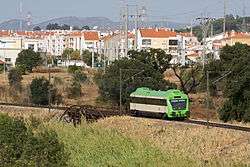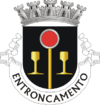Entroncamento
| Entroncamento | |||
|---|---|---|---|
| Municipality | |||
|
Diesel unit of the Beira Baixa rail line at Entroncamento | |||
| |||
 | |||
| Coordinates: 39°27′55″N 8°28′5″W / 39.46528°N 8.46806°WCoordinates: 39°27′55″N 8°28′5″W / 39.46528°N 8.46806°W | |||
| Country |
| ||
| Region | Centro | ||
| Subregion | Médio Tejo | ||
| Intermunic. comm. | Médio Tejo | ||
| District | Santarém | ||
| Parishes | 2 | ||
| Government | |||
| • President | Jaime Manuel Gonçalves Ramos (PSD) | ||
| Area | |||
| • Total | 13.728 km2 (5.300 sq mi) | ||
| Elevation | 34 m (112 ft) | ||
| Population (2011) | |||
| • Total | 20,206 | ||
| • Density | 1,500/km2 (3,800/sq mi) | ||
| Time zone | WET/WEST (UTC+0/+1) | ||
| Postal code | 2330 | ||
| Area code | 249 | ||
| Patron | Sagrada Família | ||
| Website | http://www.cm-entroncamento.pt/ | ||
Entroncamento (Portuguese pronunciation: [ẽtɾõkɐˈmẽtu]) is a Portuguese municipality in district of Santarém in the Médio Tejo Subregion (Middle Tagus) of the Centro Region. The population in 2011 was 20,206,[1] in an area of 13.73 km².[2] Situated in the Ribatejo, it benefits from its geo-strategic position along the Tagus Valley, with important accessibility to the motorways and railway-lines that historically proportioned its growth and expansion.
History

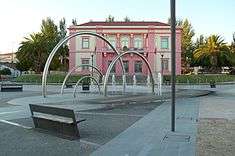
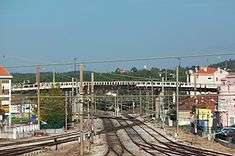
Entroncamento originated in the middle of the 19th century, with the birth of the national railway network, as a simple train-stop, from two small railway construction camps: Casal das Vaginhas and Casal das Gouveias. The majority of the early rail workers/settlers were foreign, coming from different countries throughout Europe, but eventually workers from Beira Baixa and Alentejo moved to the region.
Its toponimc name Entroncamento literally mean junction, owing to being the junction of the two railway lines that developed in 1864: the Linha do Norte (Northern Line) and the Linha do Leste (Eastern Line). Hinged between its links with the east and Beira Baixa, the station at Entroncamento, for many decades, was the obligatory stop that moved goods and people to the north and east. During this time, many celebrated travellers from Europe used the Eastern, dining in the station en route, such as the literary celebrates Hans Christian Andersen, Ramalho Ortigão, Eça de Queiroz, Alberto Pimentel, Luísa de Freitas Lomelino and Eduardo Meneres. Political leaders also became frequent visitors both before and after the 25 April Revolution, such as João Chagas, politician and journalist, who travelled to Lisbon in order to assume the direction of the new government, after the dictatorship of General Pimenta de Castro. For a long time, the two settlements were divided between two neighbouring municipalities, because the rail-line itself determined its boundary. To the west of the lines were the parishes of Santiago (in Torres Novas) and to the east the territory was part of the parish of Nossa Senhora da Assunção da Atalaia (municipality of Vila Nova da Barquinha). The small settlement continued to growing, owing to the development of rail transport and support structures, later the installation of military quarters (after 1916) determined the geographic accessibility, resulting in further influx of families.
On 25 August 1926, the settlement was elevated to the status of civil parish, in 1932, the urban designation of vila (town) and on 24 November 1945 it was elevated to the status of municipality. Until this date, its route to urban autonomy was a progressive emancipation, first separating from Torres Novas, and later from Barquinha: it was also, quite uncommon for a settlement to transform from village to town, then municipality, all within one century. From the small nucleus of families that started to populate the territory, reaching the 1930s with approximately 3000 inhabitants, by 1945 there were 8000 residents. In March 2005, it was estimated that the actual population included 18,780 residents (calculated based on the number of election-age residents). The growth in the population and expansion resulted in the creation of two new civil parishes: Nossa Senhora de Fátima, to the west of the line, and São João Baptista, to the east.
In the 1950s, Entroncamento was, after Barreiro, the second largest rail centre, representing almost half of its population. It was estimated that between the 1920s and 1930s, the population associated with the name rail operator, CP Caminhos de Ferro Portugueses /Comboios de Portugal exceeded 50% of the population. CP continued to establish structures to support its working population, including the establishment of neighbourhoods, construction of a school, warehousing and planting vegetation, dispensing anti-tuberculosis drugs to the citizenry, acting as health centre, and still further, supporting sport activities. In parallel, the evolution of technology along with rail services, helped to reinforce the level of education and training, resulting in the creation of teaching centres, such as FERNAVE, a large building that also supported the Instituto Superior de Transportes.
After the 1970s, in contrast, this changed, with the gradually substitution of coal-powered steam locomotives to diesel and electric equipment. The introduction of new technologies, assisted the unemployment of workers and the transformation of the community from labour-intensive to other technology-related services. While Entroncamento continues to have an elevated number of professionals associated with the rail industry, its economic activities have shifted to commerce and the service sectors, as well as industries associated with civil construction. Even so, INE statistics for 2004, indicated that Entroncamento continued to be the region with the largest purchasing power in the district of Santarém.
Conscious of its historical underpinnings, on 24 November 2004, the municipal authorities celebrating its anniversary, revised its municipal plan to include the construction of the Museu Nacional Ferroviário Armando Ginestal Machado and the creation of a foundation to manage its affairs, an aspiration that had been proposed in the 1970s.
Geography
Physical geography
The municipality is surrounded on all three sides by its neighbouring municipalities, including Golegã (to the south), Torres Novas (to the west and north), and the municipality of Vila Nova da Barquinha (to the east); its centre is 7 kilometres (4.3 mi) from the centre of Torres Novas, 19 kilometres (12 mi) from Tomar, 43 kilometres (27 mi) from Santarém and 120 kilometres (75 mi) from the Portuguese capital, Lisbon.
Human geography
|
|
The growth rate, between 1981 and 1991, was 18.1%, considered the most elevated in the Médio Tejo, contradicting the national trend towards aging. Between 1991 and 1996, the population grew from 14,226 inhabitants to 15,500, with a lower growth rate (9%), although it was still the community with the highest urban population density in the Médio Tejo. The estimated population (18,780), does not include resident listed in other localities, nor the fluctuating values due to temporary workers. Effectively, Entroncamento maintains a population of over 20,000 inhabitants.
The municipality consists of two civil parishes (freguesias) that are principally divided by the national railway-line that crosses its territory from south-southwest to north-northeast:[3]
- Nossa Senhora de Fátima
- São João Baptista
Twin towns — Sister cities
Along with its fraternal sister-city of Penafiel, Entroncamento is twinned with:

Economy
The municipality decided to invest heavily in construction of primary fiber optic links that can connect all municipal services, such as parish councils, sports complex, sports hall, schools, chamber, library, cultural center and that in the future may also enable installation of telemetry system and video surveillance set up and let the infrastructure required for a FTTH network. - Fibra no Entroncamento
Railway museum
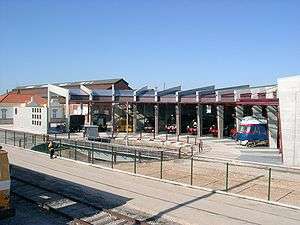
References
- ↑ Instituto Nacional de Estatística
- ↑ Direção-Geral do Território
- ↑ Diário da República. "Law nr. 11-A/2013, page 552 44" (pdf) (in Portuguese). Retrieved 22 July 2014.
- 1 2 C.M.E.-Geminações
